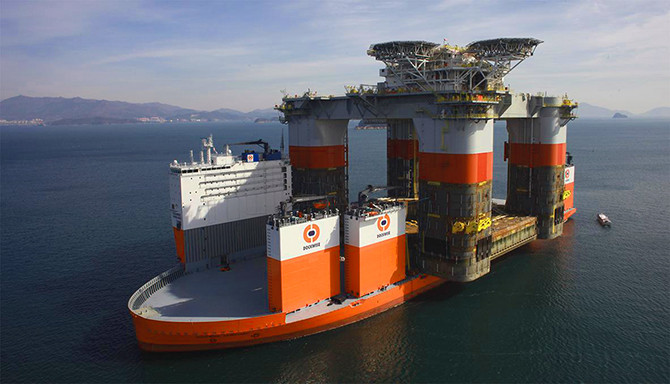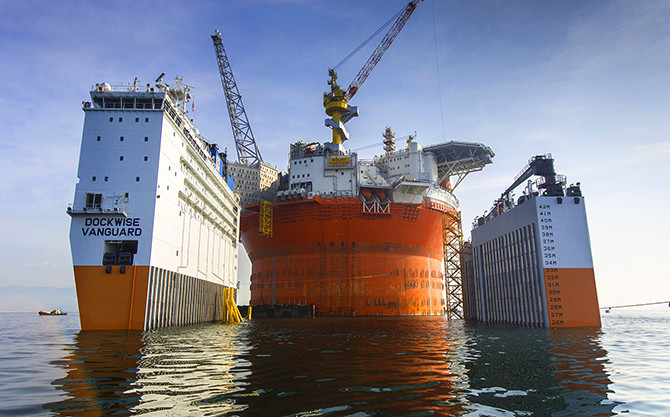How does the school's super transport vessel operate?
Dockwise Vanguard is the most super-heavy school transport vessel today . It was used to transport large ships like the Costa Concordia yacht, or to bring offshore oil rigs. So how does this transport ship "shoulder" such super-heavy items?
The need to transport large volumes of goods by sea has prompted the birth of "monster" ships that are capable of transporting superiority, even carrying . other ships, or no any amount of goods that conventional ships cannot afford.

Dockwise Vanguard "carries" an oil rig.
The first prototype of the supernova carrier was MV Lichtenfels , built in the 1920s by transportation company GA Hansa. After World War II, DG Hansa became the world's most famous heavy carrier. However, that title is now in the hands of Dockwise Group (Netherlands) with the highest number of high-class transport ships in the world (19 ships), diverse for all types and purposes.
A lot of huge transport types have been distributed and operated by Dockwise, including Mighty Servant 1 models, MV Blue Marlin, MV Black Marlin and Vanguard. Vanguard is the largest model ever built by Dockwise because it can carry up to 117,000 tons. It can transport offshore oil rigs, and also bring other ships to the docks.
Vanguard is 275m x 70m in size, the deck area is 19,250m 2, so it can transport 50% larger than the Blue Marlin. This is a semi-submersible vessel with an open design, the deck can be lowered to 16m below the surface to allow other ships or cargo to swim and dock. The deck is also designed to allow water to flow through and does not pose a danger to the vessel.

The ship can sink under water 16m.
The ship's ability to sink / float is achieved by dedicated Ballast water tanks. Accordingly, seawater will be pumped into this tank so that the vessel can sink deep under the water, and pump out water to float the vessel.
Due to the ability to piggyback on other ships, Vanguard can also act as floating dock system to repair ships and boats right at sea. The vessel can also receive cargo from the dock, via sliding into the rail.
When carrying other ships, its level of terrorism could be doubled because the ship itself had 116,173 tons of water extension, and in addition to carrying 117,000 tons of cargo, the maximum tonnage could be amounted to 233,173 tons.
The towers are designed to easily move on the side of the ship as well as to ensure the safety of the crew of about 40 people. Crew accommodation, including rescue crews, is on the starboard side of the ship.
Vanguard is equipped with two Wartsila 6L38 engines and two Wartsila 12V38 engines , in addition to the Wartsila 6L20 auxiliary engine . The world's largest diesel engine system allows the ship to travel at 14 knots.

4 towers on board can move flexibly.
Hyundai Heavy Industries (HHI) helped Dockwise build Vanguard from the second half of 2011, until February 2013 the super ship was officially handed over to Dutch partners. Vanguard, once named Type-0, has a total cost of completion of up to 240 million USD. Since 2014, Dockwise has begun to study the production of Vanguard successor ships, the super-vessel is expected to be larger in size and capacity than its predecessor, but so far no information has been found. This 2nd generation Vanguard ship.
- Cygnus private transport vessel leaves the International Space Station
- Vietnam satellite hits the space station
- Boeing is about to unveil the space transport ship
- Transport aircraft contribute to super products 'Fast & Furious 7'
- Russia: Transport ship Progress M-24M successfully assembled with ISS
- Kounotori 5 Japanese transport ship leaves ISS to return to Earth
- Russia launched a space transport ship carrying 2.4 tons of cargo to ISS
- Russia successfully launched the transport ship 'Progress M-28M' into orbit
- Launched the world's first super speed train to run faster than aircraft
- More than 20 Fukushima schools are highly radioactive
- Transport vessel 'Progress M-20M' connected to the ISS Station
- The shuttle's juniors
 'Fine laughs' - Scary and painful torture in ancient times
'Fine laughs' - Scary and painful torture in ancient times The sequence of numbers 142857 of the Egyptian pyramids is known as the strangest number in the world - Why?
The sequence of numbers 142857 of the Egyptian pyramids is known as the strangest number in the world - Why? History of the iron
History of the iron What is alum?
What is alum? What makes ships go in circles?
What makes ships go in circles?  'Super' unmanned aircraft monitors ships causing pollution
'Super' unmanned aircraft monitors ships causing pollution  Kazakhstan: The ghost fleet comes out amidst the desert
Kazakhstan: The ghost fleet comes out amidst the desert  Seamless water battleship does not rival the US Navy
Seamless water battleship does not rival the US Navy  Global Firepower ranks Air Force, Navy Vietnam
Global Firepower ranks Air Force, Navy Vietnam  'New Bermuda Devil Triangle' swallowed dozens of boats off China
'New Bermuda Devil Triangle' swallowed dozens of boats off China 